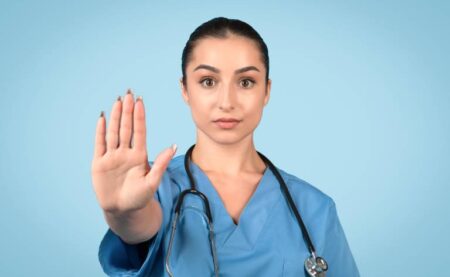Nurse Insights: What Gadgets Are Essential for Nurses?
Nursing is a demanding profession that requires a combination of knowledge, skill, and the use of modern technology. In this article, we explore some of the must-have gadgets and practical accessories that can enhance patient care and simplify nursing tasks. These include digital stethoscopes, smartwatches, fitness trackers, and handheld portable ultrasound devices. Here, we discuss the advantages of each and how they can help nurses improve their performance and quality of care.
Nurse Insights
What Gadgets Are Essential for Nurses?
In our Nurse Insights series, experienced nurses offer an insider’s perspective on the nursing profession by addressing common questions, challenges, and triumphs of their careers.
Digital Stethoscopes
As a nurse, understanding and utilizing modern technology, such as digital stethoscopes, can greatly improve your ability to assess and monitor patients.
Sound Clarity and Noise Reduction
Digital stethoscopes provide incredible sound clarity when it comes to evaluating a patient’s heartbeat. They are specially designed to reduce ambient noise, ensuring that you hear only what is important during an examination. This means noises such as conversation, equipment operation, or even the typical hustle and bustle of a busy hospital ward will be less likely to interfere with your auditory assessment of the patient’s heart.
Traditional stethoscopes pick up all sounds around them, but the processing technology of digital stethoscopes reduces background distractions. That’s like switching from a standard TV to a high-definition one—the sounds you need to hear become sharper and clearer.
Data Storage and Sharing
Furthermore, digital stethoscopes can store the auscultations electronically. Traditionally, recordings would have to be handwritten with the possibility of inaccuracy or even loss of the data. The electronic data storage allows for more accurate records, comparison over time, and easy sharing with other healthcare providers. This is particularly useful when patient cases are complex and require collaboration among multiple healthcare team members or when you need to monitor changes in a patient’s heart condition over time.
Additionally, the ability to store data electronically allows you to revisit heart sounds for learning and improvement in diagnostic skills. Learning to use a digital stethoscope early in your career could aid your nursing practice, augmenting your auditory skillset while providing better care to your patients.
Smartwatches & Fitness Trackers
Smartwatches and fitness trackers can play a valuable role in managing a nurse’s health and stress during shifts.
Stress Monitoring
Today’s advanced smartwatches and fitness trackers are equipped with stress-detection features. These devices use heart rate variability (HRV), skin temperature, and other biological indicators to calculate stress levels. When elevated stress is detected, these devices can send alerts, prompting you to take a break, perform a calming exercise, or hydrate. Consistently monitoring and addressing your stress throughout a shift can help maintain peak mental agility and reduce the likelihood of burnout.
Sleep Quality
Working long hours can significantly impact your sleep quality. Numerous smartwatches and fitness trackers monitor sleep patterns, providing insightful data such as how much deep sleep you’re getting and interruptions during sleep. Understanding your sleep patterns can help you make necessary adjustments and improvements to ensure optimal rest during off-hours, allowing for maximum recovery and performance during your shifts.
Activity Levels
Fitness trackers and smartwatches also monitor daily activity and exercise, reminding you to move if you’ve been inactive for too long. Staying physically active can increase stamina, reduce fatigue, and help maintain a healthy lifestyle in a demanding profession like nursing.
Health Checks
Some advanced wearable devices also offer ECG and SpO2 monitoring, both of which can be valuable for monitoring overall health. While these features cannot replace professional medical advice or diagnosis, they can provide supplemental information that could potentially be addressed with a healthcare professional if concerning patterns are detected.
Handheld Portable Ultrasound Devices
Handheld portable ultrasound devices, often referred to as point-of-care ultrasound (POCUS), are essential tools for modern nursing. Since they are compact and portable, they allow registered nurses to perform diagnostic imaging right at the patient’s bedside, significantly reducing the time it takes to obtain critical diagnostic information.
Quick Scans
With a handheld ultrasound, quick scans can be performed anywhere—in the ER, ICU, or even in the field. This immediacy not only saves valuable time but also spares the patient the stress and risks of transportation. For a patient with potential internal bleeding, a fractured bone, or a lung infection, having the ability to instantly assess the severity of their condition can be lifesaving.
Moreover, these devices are easy to use, making it possible for more members of the healthcare team to perform a scan. This means that diagnosis and treatment can begin more quickly, without having to wait for an available sonographer or radiologist.
Instant Triage Decisions
In emergency scenarios, speed is of the essence. Being able to confidently make triage decisions quickly is crucial to a patient’s survival. Handheld ultrasound devices can provide immediate visual confirmation of conditions like cardiac tamponade, pneumothorax, or hemothorax, which otherwise would require more time-consuming tests to verify.
Without this instant information, you would have to rely solely on less definitive signs and symptoms, which could potentially lead to delayed or incorrect diagnosis. With the instant insights handheld ultrasound devices provide, you can make quicker, more accurate triage decisions, accelerating the provision of appropriate treatment and care.
In addition, handheld ultrasound devices have superior specificity and sensitivity compared to traditional physical examination techniques. This improved accuracy helps to increase confidence in your diagnostic and triage decisions, reducing the likelihood of errors and improving overall patient outcomes.
However, while handheld ultrasound devices are extraordinarily useful, they are not a replacement for comprehensive imaging studies when indicated. They serve as a supplement, providing immediate information that can guide your decisions until a more thorough evaluation can be performed.
Portable Glucometers
For nurses with diabetes, portable glucometers are an essential tool for monitoring and managing diabetes while at work or at home. They provide almost immediate feedback on blood glucose levels, which can guide decisions about food, physical activity, and medication.
Here are a few key advantages of using these compact, easy-to-use devices:
- Immediate Results: Portable glucometers offer immediate results. This allows you to make quick decisions about managing high or low blood sugar levels. If your blood sugar is too high, you might need to take more insulin, while if it’s too low, a snack might be needed.
- Small and Portable: Another great advantage is their portability. These devices fit easily into a pocket or purse, allowing you to check your blood sugar levels anywhere and anytime. This ensures that you’re never without this vital information—whether you’re at work, at a restaurant, or on vacation.
- Easy to Use: Understanding how to use a glucometer efficiently is necessary for managing diabetes. What sets portable glucometers apart is that they’re designed to be user-friendly. Most require just a small drop of blood and will display the result on-screen within seconds. Some models even store these results, simplifying record-keeping.
Electronic Health Record (EHR) Systems
As a nurse, an important part of patient care that you’ll need to become familiar with is electronic health record (EHR) systems. EHRs are essentially digital versions of paper charts, but far more comprehensive. They contain real-time, patient-centered records accessible to authorized users across healthcare providers.
Streamlining Patient Care
Through an EHR, you’ll have access to a complete history of the patient: diagnoses, treatment plans, immunization dates, allergies, radiology images, lab tests, etc, thereby streamlining the process of patient care. Knowing all relevant medical histories at a glance can help you make better, faster, and safer decisions about a patient’s care.
For instance, if a patient is allergic to a certain medication, this information would be recorded in their EHR. As a result, a red flag could be automatically raised if you, or any healthcare provider, attempt to prescribe the allergenic medication, thus helping to prevent serious errors.
Administration-wise, EHRs can also create efficiencies. They reduce the need for paper and the physical storage space it requires.
However, EHRs also come with challenges. You need to ensure patient confidentiality while consistently entering information accurately and promptly, and the systems can sometimes be complex to navigate. Regular training and updates are necessary to keep your skills sharp and up-to-date.
Smartphone and Medical Apps
Smartphones and medical apps are becoming increasingly valued tools in the nursing field. Equipped with these digital aids, you can streamline your nursing duties and improve patient care.
Role of Smartphones
These compact devices are more than just communication tools; they are portable computers that can assist you in your clinical practice. Accessing electronic health records, referencing nursing guides, or quickly checking drug interactions is possible through smartphone apps, making them incredibly convenient in busy scenarios or during outreach.
Medical Apps
When it comes to specific medical apps, these applications provide a multitude of features. Disease diagnosis apps, for instance, can aid in identifying symptoms and conditions, making initial assessments more efficient. Apps such as Epocrates or Medscape offer a comprehensive medicinal database for cross-referencing, which can prevent adverse drug interactions.
Furthermore, language barrier issues can be mitigated with language translation apps, enhancing communication and understanding between healthcare providers and patients from different linguistic backgrounds.
Telemedicine and Remote Care
Aside from in-person duties, smartphones coupled with telemedicine apps excel in providing remote care. Guided home care, virtual check-ins, and online consultations can be conducted, keeping you connected with your patients. These are particularly handy in scenarios where distance or mobility might be a hindrance.
As a healthcare professional, incorporating digital tools into your daily practice can significantly improve patient outcomes, as well as reduce medical errors and associated costs. Furthermore, these technologies can help you streamline your workflow, allowing you to focus on providing high-quality care to your patients.



